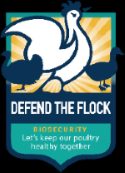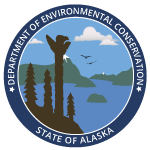Highly Pathogenic Avian Influenza (HPAI)
On This page
HPAI Outbreak History
Avian influenza is a viral disease primarily affecting birds, both domestic and wild. Wild waterfowl are the main reservoir. They can be infected and shed the virus without displaying any symptoms. Avian influenza viruses are categorized as low pathogenic or highly pathogenic, based on the severity of illness in domestic poultry. Highly pathogenic avian influenza (HPAI) viruses can cause mortality of 90-100% of the birds in an affected flock.
The currently circulating H5N1 HPAI strain emerged in 2020 in Europe. It was first detected in the U.S. in January of 2022 in wild birds, and in February of 2022 in poultry. Since then, it has continued to circulate in wild birds, resulting in continued spread to domestic poultry. Millions of poultry have been affected throughout the country. Sporadic spillover events from birds to mammals have occurred, and many other wild bird species have died from the virus.
In the spring of 2024, a spillover event of HPAI from wild birds to dairy cattle occurred in the Texas panhandle area. As of March 2025, this particular strain, H5N1 clade 2.3.4.4b, genotype B3.13, has spread to over 900 herds in 17 different states. It has spread to cattle in other herds and states from the movement of infected cattle, equipment and people. The cattle strain has not moved back into migratory wild birds. In February 2025, 2 new spillover events of a different strain (H5N1 clade 2.3.4.4b, genotype D1.1) occurred from wild birds to dairy cattle in Arizona and Nevada, but so far the virus has not spread beyond those farms.
HPAI in Alaska
H5N1 avian influenza was detected in Alaska in the spring of 2022. Since then, the virus has been confirmed in multiple domestic poultry flocks experiencing high rates of mortality. These case counts are shown in the table at the bottom of this page. It has also been detected in red foxes, a brown bear, a black bear, 2 polar bears, an Arctic fox, and an ermine, as well as over 30 species of wild birds.
There have been no cases of HPAI in cattle, humans, or domestic mammals in Alaska. Several other states have had cases in cats on dairy farms, as well as in cats that consumed infected raw meat products. The recalled raw pet food products have not been distributed in Alaska. However, it is not recommended to feed pets raw meat or milk products, nor to consume raw milk.
Although there have been some human cases in the U.S., they have mainly been in people with close contact with sick or dead birds infected with HPAI. There have been a few reports of serious illness or death, but the majority of human cases have shown mild symptoms, primarily conjunctivitis. At this time the risk of HPAI to humans is still considered low.
Alaska’s Office of the State Veterinarian (OSV) is continuing to work with partner agencies for surveillance activities, morbidity or mortality investigations in domestic or wild birds, and outreach to poultry producers, subsistence hunters, veterinarians, and consumers. With the emergence of the virus in dairy cattle, we have also provided outreach to dairy and livestock producers.
Collaborative partners include the United States Department of Agriculture’s (USDA) Animal and Plant Health Inspection Service (APHIS), the United States Fish and Wildlife Service (USFWS), the Alaska Department of Fish and Game (ADFG), the United States Geological Survey (USGS), the USDA APHIS Wildlife Services, the Alaska Native Tribal Health Consortium (ANTHC), North Slope Borough, and the Alaska Department of Health.
Press Releases
- Avian Flu Confirmed in Alaska (5/2/22)
- Avian Flu Confirmed in Wild Birds at Multiple Alaska Locations (5/9/22)
- Office of the State Veterinarian Confirms Avian Influenza in Alaska (10/11/22)
- Black Bear Cub in Alaska Diagnosed with Avian Influenza (11/18/22)
- State of Alaska Epidemiology Bulletin: H5N1 Avian Influenza — Alaska, 2022–2023 (6/28/23)
- Detection of Highly Pathogenic Avian Influenza in Dairy Herds (4/4/24)
Protecting Your Flock
To protect domestic poultry from HPAI, it is recommended to use good biosecurity practices, monitor for signs of illness, and notify your veterinarian or the appropriate agency if you observe concerns in wild or domestic animals.
Signs to Watch For
- Sudden death
- Respiratory distress
- Nasal discharge, sneezing, and coughing
- Abnormal behavior or difficulty walking
- Diarrhea
- Lethargy
- Blue discoloration of comb and wattles
- Swollen comb, wattles, legs, or head
Who to Contact
To report illness or death in a backyard flock, please contact your local veterinarian or the Office of the State Veterinarian at 907-375-8215.
To report observations and concerns about migratory birds, email ak_mbm@fws.gov or call 1-866-527-3358.
To report observations and concerns about other wildlife, please contact your local Alaska Department of Fish and Game office.
If your pet is ill, please contact your local veterinarian.
Prevention: What You Can Do
- Use good biosecurity practices on your farm!
- If you have a pond nearby where waterfowl may be, do not allow your chickens or ducks near the water.
- Keep feed protected from wild birds or other wildlife.
- Keep poultry under cover or otherwise limit free ranging to prevent contact with wild birds.
- Change clothes and boots before going to another farm or area with birds.
- Do not share equipment and supplies with other bird owners.
- Isolate new birds for 30 days before adding them to your flock.
- Wash hands thoroughly after handling or working with birds. Wear clean clothes, and disinfect cages or equipment that come in contact with birds and their droppings.
- Keep pets away from wild birds. It is not recommended to feed raw meat or raw milk products to pets.
- When handling and cleaning game, hunters should wear gloves, wash hands, and disinfect knives and equipment used for cleaning. Use caution if you have domestic birds at home.

USDA APHIS Defend the Flock Program
The USDA’s Animal and Plant Health Inspection Service (APHIS) developed the Defend the Flock public education program for poultry owners. On the Defend the Flock website you can view educational handouts, videos, webinars and other resources. You can also follow the Defend the Flock program on Facebook and X.
Additional Resources
- Avian Influenza (USDA APHIS)
- Avian Influenza (Bird Flu) (CDC)
- HPAI in Livestock (USDA APHIS)
- National Milk Testing Strategy (USDA APHIS)
- Current Situation: Bird Flu in Dairy Cows (CDC)
- HPAI and Migratory Birds in Alaska (U.S. Fish and Wildlife Service)
- HPAI and Human Health (Alaska Department of Health)
- Avian Influenza (H5N1) in Alaska (Alaska Department of Health)
- Includes FAQs related to subsistence hunting, backyard flocks, food safety, dead wildlife, and marine mammals.
Confirmations of HPAI in Alaska
Confirmations of HPAI in Domestic Animals in Alaska 2022-Present
| Confirmation Date | Borough/Census Area | Species | Animals Affected | Strain |
|---|---|---|---|---|
| 4/29/2022 | Matanuska-Susitna Borough | Mixed Domestic Poultry | 30 | EA H5N1 |
| 10/1/2022 | Matanuska-Susitna Borough | Mixed Domestic Poultry | 10 | EA H5N1 |
| 8/2/2022** | Bethel Census Area | Chickens | 4 | EA H5N1 |
| 9/29/2022 | Matanuska-Susitna Borough | Chickens | 40 | EA H5N1 |
| 10/12/2022 | Matanuska-Susitna Borough | Mixed Domestic Poultry | 1000 | EA H5N1 |
| 11/25/2022 | Matanuska-Susitna Borough | Mixed Domestic Poultry | 33 | EA H5N1 |
| 10/28/2023 | Matanuska-Susitna Borough | Mixed Domestic Poultry | 49 | EA H5N1 |
| 10/28/2023 | Matanuska-Susitna Borough | Mixed Domestic Poultry | 10 | EA H5N1 |
| 11/8/2023 | Matanuska-Susitna Borough | Mixed Domestic Poultry | 4 | EA H5N1 |
| 11/20/2024 | Matanuska-Susitna Borough | Mixed Domestic Poultry | 25 | EA H5N1 |
| 11/26/2024 | Matanuska-Susitna Borough | Mixed Domestic Poultry | 73 | EA H5N1 |
**Mortalities of domestic chickens occurred in early May. Samples were processed and confirmed 8/2/2022.
Note: Table will be updated as results become available. Case counts in national databases may be updated at a different intervals, and therefore there may be some discrepancies between reporting on federal and state websites.
Note: H5N1 is a highly pathogenic strain. Low pathogenic strains can also be present in wild waterfowl, but do not pose as high of a risk to domestic poultry.
Confirmations of HPAI in Wild Animals in Alaska 2022-2023
For a list of confirmations of HPAI related to morbidity or mortality events in wild animals in Alaska in prior years, see the Confirmations of Avian Influenza in Alaska 2022-2023 webpage.
For information about all detections of HPAI in domestic birds, wild birds, livestock, and other mammal species visit the USDA APHIS's Detections of HPAI website.

 Indicates an external site.
Indicates an external site.